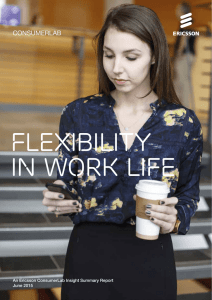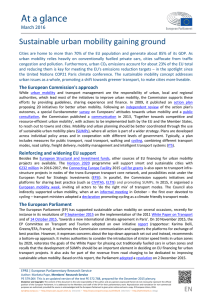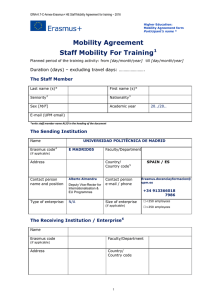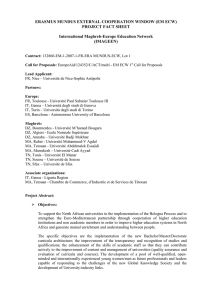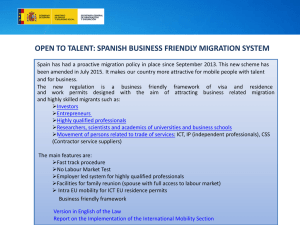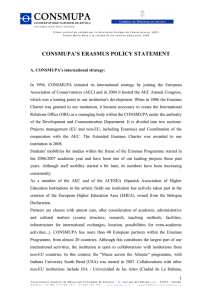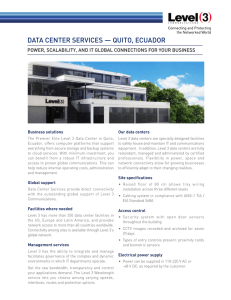Business Users Go Mobile
Anuncio
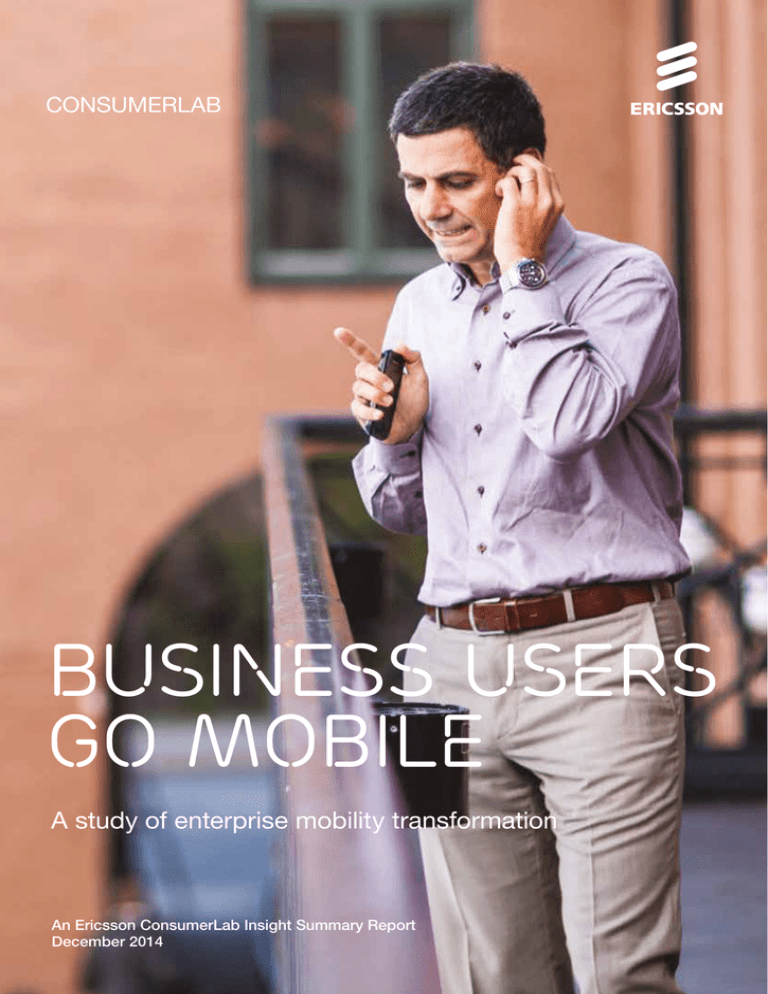
CONSUMERLAB BUSINESS USERS GO MOBILE A study of enterprise mobility transformation An Ericsson ConsumerLab Insight Summary Report December 2014 ERICSSON CONSUMERLAB GAMING IN THE NETWORKED SOCIETY 1 contents EVOLVING ENTERPRISE 3 ADDING TO THE DEVICE MIX 7 MOBILITY IS BUSINESS CRITICAL 4 THE EVOLUTION OF BYO 8 THE IMPORTANCE OF CONNECTIVITY 6 THE PERFECT BUNDLE 10 METHODOLOGY Qualitative Face-to-face interviews took place on company premises throughout Chicago. 1 hour interviews were conducted with 15 decision makers, including CIOs, VPs of IT, and IT Directors. 30 minute interviews with 14 business users were also conducted. The target businesses ranged from medium sized (250 to 999 employees) to larger enterprises (1,000+ employees), in a mix of industries, such as manufacturing, financial, health, leisure, legal and wholesale. The target businesses had a high proportion of employees using technology in their daily work, and had taken big steps towards achieving a mobile workplace by providing a multitude of supporting technology. Quantitative Online survey with 749 participants in Northeast, South, West and Midwest USA. 248 of these respondents were decision makers or significant influencers regarding IT solutions, including 81 CIOs/CTOs. 501 respondents were full-time knowledge workers who operate away from their main place of work or desk for at least 20 percent of the time. They also use at least two mobile devices at work and spend at least 50 percent of work time using technology. The target businesses all had 500 US-based employees or more. The largest studied business had more than 10,000 employees. The businesses included a mix of industries, such as manufacturing, financial, health, leisure, legal and wholesale. Business user data was weighted based on company size to represent the decision maker data. The sample, both from a business user and decision maker perspective, is representative for the type of roles and businesses outlined above, rather than for the entire US enterprise market. This sample is estimated to represent approximately 5,000 companies and 5 million business users. How mobility is defined by decision makers During the interviews it was clear that for most decision makers, mobility means having access to work anywhere and anytime, with many thinking it was primarily to do with working away from the office. Situations most commonly thought of included working from home or from other business sites. Many decision makers also took into account their field-based and travelling staff when talking about mobility. However, mobility within a site or office was often not at the forefront of decision makers’ minds, even though they naturally see it as being very important. It was only after some discussion and reflection that the role of both indoor mobility and devices were considered. 2 ERICSSON CONSUMERLAB BUSINESS USERS GO MOBILE Mobility for me means you can work from anywhere. It doesn’t matter if you are in the office physically anymore.” CIO, financial industry, US Decision makers Business users (CIO/CTO and IT directors) rce Transf orm Unwired y The following colors will represent the two participant groups in this study fo rk through mob ilit ion at Increasing demand from users to access information on the go via mobile platforms means that mobile enterprise is a rapidly evolving area. Mobility has become a business necessity, creating new ways of working and transforming processes. Companies have to adapt quickly and need to be sure that security, governance and compliance policies remain intact across devices, data and applications. It is therefore extremely important to understand the implications of enterprise mobility, as well as future business transformation requirements, both from a business user and a decision maker’s perspective. wo Evolving enterprise Improved business efficiency and productivity Improved customer and partner engagement Key findings > Mobility is important Decision makers and business users agree on the importance of mobility, with 7 out of 10 CIO/ CTOs regarding it as business critical. Both decision makers and business users will benefit from mobility and there will be few barriers. >Smartphones create competitive advantages Mobility and smartphones support business interactions with partners and customers. The smartphone is the preferred device for business calls to people outside of the company. 6 out of 10 business users make calls on their smartphone for this purpose. >The need for indoor coverage has increased Indoor mobile coverage is important, and needs to be improved. 9 out of 10 decision makers agree that indoor data traffic over 3G/4G/LTE has increased compared to 2 years ago. > New devices do not replace old ones There is a continuous addition of new devices, rather than the replacement of one with another. For example, over the past 2 years there has been a 60 percent increase in the number of companies that provide smartphones to their employees. However, a large number of fixed devices are still used, as there is no suitable option for an all-in-one device. > Bring Your Own in demand Business users today expect to be able to choose which device to use – and Bring Your Own (BYO) personal device to work is now common practice. Today 8 out of 10 companies support some level of BYO. In fact, 7 out of 10 decision makers are positive about BYO, compared to 5 out of 10 business users. Interest levels in BYO are increasing with the introduction of reimbursement schemes, such as a stipend. >Connectivity is a key component in the ideal bundle There is an opportunity for operators to offer connectivity outsourcing. 7 out of 10 decision makers would take up a bundle where the key components include connectivity with emphasis on 3G/4G/LTE. ERICSSON CONSUMERLAB BUSINESS USERS GO MOBILE 3 MOBILITY IS BUSINESS CRITICAL Decision makers and business users agree on the importance of mobility, with 7 out of 10 CIO/CTOs believing it to be business critical. The main benefits include better communication and collaboration, leading to higher employee satisfaction. In addition, mobility provides better solutions to meet clients’ needs, leading to more productive staff and a competitive advantage. The benefits of mobility outweigh the disadvantages, however security was named as a barrier by 6 out of 10 decision makers. They feel, for example, that there is a risk of sensitive information being exposed through lost devices or data fraud. Figure 1: The benefits of mobility DECISION MAKERS BUSINESS USERS 50% 47% 42% 40% 40% 40% 38% 37% 36% 31% 30% 29% 28% 20% 10% in as k at tm ul ra te Be t om m un rc Be tte tit ic ey th he re w k w or Ca n g n io lik e or e m do Ca n uc tiv e pr od M or e Be m tte ee r s t c ol lie uti nt on ne s t ed o C s om pe tit ive ad va nt ag e tim Qu e ick (e er .g re .t s o po cl n ie se nt s) H ig he r sa em tis pl fa oy ct ee io M n or e pr od uc tiv e st af f 0% Source: Ericsson ConsumerLab Business Users Go Mobile, 2014. Base: All decision makers and business users Within an enterprise, user groups have different mobility needs. Super mobile users mostly include knowledge workers and operational staff who work away from the office or in different locations most of the time. User groups have different mobility needs and levels of access Moderately mobile groups could include knowledge workers who spend most of their time in the office but some of their time in another location. 4 ERICSSON CONSUMERLAB BUSINESS USERS GO MOBILE The workforce excluded from mobility would, for example, be blue collar workers or users that are on hourly contracts. Enterprises may have all of these user groups, or just one or two. The extent to which enterprises grant corporate access to their employees also varies. Different user groups within the same company were given different levels of access, ranging from just email, calendars and contacts, to company-specific apps and video functionality, full remote access, and access to sensitive company data on mobile devices. We have to adopt, use and leverage as much as possible to improve efficiency, employee expectations, and competitive advantages.” Decision maker, leisure industry, US Keeping up with demand Mobility is often driven by business users, management actions or requests within the enterprise, as well as customers’ expectations for instant access and information. New technology is also crucial to attracting new employees, in particular a young, bright workforce. Mobility plays a big part in the younger generation’s daily lives, meaning they expect nothing less from their work lives. Most decision makers are satisfied with the mobility solutions they have in place, in contrast to the business users who perceive more gaps in their company’s ability to support their mobility needs. While decision makers may feel their company already provides adequate mobility solutions, business users express a need for improvement in their ability to work remotely or from home, as well as a desire for higher quality mobile data coverage inside the office. WHAT DRIVES MOBILITY? Staff choose to buy personal mobile devices Management, executives and knowledge workers articulate mobility needs The younger generation is used to new technology and desires it in the workplace ERICSSON CONSUMERLAB BUSINESS USERS GO MOBILE 5 THE IMPORTANCE OF CONNECTIVITY 7 out of 10 Very or extremely satisfied with mobile network coverage Decision makers 5 out of 10 Business users Across the companies examined, there is no single connectivity method that applies to them all. Wi-Fi is provided by 8 out of 10 companies, and mobile data plans are provided by almost as many. Figure 2 shows that when it comes to satisfaction with network coverage, 8 out of 10 decision makers are extremely or very satisfied with their fixed and Wi-Fi internet connection. Mobile data provisioning shows significant growth, whereas fixed internet connections have reduced by 20 percent compared to 2 years ago. However there is a significant difference in perception of mobile network coverage satisfaction. 7 out of 10 decision makers are very or extremely satisfied, compared to 5 out of 10 business users. Automatic connectivity Business users do not think about their smartphone or tablet connectivity much in their day-today work. The different types of connectivity could even be a bit confusing. Business users often do not know whether they are using a Wi-Fi or mobile connection when moving around − they simply let the mobile device make that choice. Figure 2: Satisfaction with network coverage DECISION MAKERS BUSINESS USERS 32% 48% Fixed internet 31% 48% Wi-Fi (indoor) 40% 32% 36% 80% 70% 60% 40% Decision makers – Very satisfied 30% 10% 0% Decision makers – Extremely satisfied Source: Ericsson ConsumerLab Business Users Go Mobile, 2014 Base: All decision makers and business users 6 ERICSSON CONSUMERLAB BUSINESS USERS GO MOBILE 24% 20% 3G/4G/LTE (outdoor) 20% 34% 29% 3G/4G/LTE (indoor) 36% 50% 27% 32% 19% 0% 10% 30% 20% 30% 40% Business users – Extremely satisfied 50% 60% 70% 80% Business users – Very satisfied ADDING TO THE device MIX There is an ongoing evolution towards more mobile enterprise, and the explosion in smartphone and tablet usage is continuing this transformation. However, decision makers and business users are not ready to let go of fixed devices. Instead, the technology evolution has led to an uptake of second or third devices, rather than a complete replacement of less mobile ones. Figure 3: Devices used for work Laptops 22% LAPTOP Laptops are provided by more than 8 out of 10 companies to at least part of their workforce. Business users tend to use fixed connections via a docking station when at their desk, and use company Wi-Fi when away from it. 12% 41% TABLET Today, 7 out of 10 companies provide tablets to at least part of their workforce. Decision makers typically see tablets as a user-friendly extension of smartphone capability. However, they express hope that future versions of tablets will support wider usage, thus enabling the replacement of laptops. SMARTPHONE Almost 9 out of 10 companies provide smartphones to at least part of their workforce. 6 out of 10 business users use the smartphone when it comes to making calls to parties not working at the same company. DESKTOP COMPUTER 8 out of 10 companies provide desktop computers to their workforce. Desktop computers are, for example, used by staff with limited mobility needs, or those who work with data-heavy functions such as CAD programs. DESK PHONE The fixed desk phone still plays an important role, and almost 9 out of 10 companies provide it to at least part of their workforce. Many of the studied companies have opted for upgrades to VoIP systems. 25% Tablets 11% 16% 48% 25% 25% Smartphones 19% 19% Benefits include integration with Lync or the ability to see if colleagues are available. As many as 9 out of 10 business users use their desk phone to make internal work calls. 21% 41% Enterprise mobility is influenced by the number of connected devices in use. A significant portion of business users have 2 smartphones at work. In fact, 41 percent use both a personal and company-provided smartphone. On the other hand, 21 percent use only a personal smartphone for work and 19 percent use only a company-provided smartphone. Decision makers and business users agree that usage of smartphones has improved business interaction with external parties and customers, creating a competitive advantage. Only use a company-provided device for work Only use a personal device for work Use both personal and companyprovided devices for work Don’t use a device for work Source: Ericsson ConsumerLab Business Users Go Mobile, 2014. Base: All business users ERICSSON CONSUMERLAB BUSINESS USERS GO MOBILE 7 THE EVOLUTION OF BYO Traditionally, many companies have provided company-owned mobile phones to certain employees. However with the widespread personal usage of smartphones, business users expect to choose their own device – and BYO device is now common practice. This is in turn leading to business users pushing for company functionality to be made available on their personal devices. Figure 4: Decision makers’ plans for BYO Have BYO 4% Considering BYO 10% Do not accept BYO 8% Do not know 78% To accommodate this, businesses have experienced a shift away from company-owned to BYO models. Figure 4 shows that almost 80 percent of companies support some level of BYO. Wider adoption and support of BYO tends to come from companies or business users who are more technically advanced, but as many as 7 out of 10 decision makers are positive about BYO. Benefits of BYO include better client work, efficient device management, increased employee satisfaction, and the ability to stay on the cutting edge of technology, thanks to the adoption of the latest devices and solutions. Positive attitudes to stipend Many companies that provide BYO have recently moved to a stipend system where the business user chooses the device and provider, and simply receives a set amount each month towards the cost of the bill − typically between USD 40-120. In fact, 6 out of 10 BYO companies offer stipends to cover the cost of BYO. Figure 5 shows that business users become more positive towards a BYO system with the introduction of a reimbursement scheme. The majority of business users who receive a stipend think it is large enough to cover expenses, with only 3 out of 10 saying the reimbursement is insufficient. Source: Ericsson ConsumerLab Business Users Go Mobile, 2014 Base: All decision makers Figure 5: Attitudes to BYO 74% positive Decision makers 12% 31% 32% 11% 47% positive User – if not reimbursed 26% 19% 18% 10% 59% positive User – if reimbursed 24% Extremely negative Very negative Somewhat negative Somewhat positive Very positive Extremely positive 8 ERICSSON CONSUMERLAB BUSINESS USERS GO MOBILE 22% Neither positive nor negative 23% 14% Source: Ericsson ConsumerLab Business Users Go Mobile, 2014 Base: All decision makers and business users Figure 6: Level of access provided by BYO companies 71% Corporate email Some business applications 70% Intranet web pages 64% Full corporate access, wherever you are 43% 0% 10% 20% 30% 40% 50% 60% 70% 80% Source: Ericsson ConsumerLab Business Users Go Mobile, 2014 Base: All decision makers 71 PERCENT of BYO companies provide corporate email access Staying secure Security is a key issue in regards to mobility, and companies provide different levels of access to users. Figure 6 shows that 71 percent of BYO companies provide corporate email access, whereas full corporate access is provided by only 43 percent. If we had the funds, I would like to provide all of our devices, giving us better control and the ability to wipe them completely if necessary.” Decision maker, health sector, US However, some companies have chosen not to implement BYO. One reason could be security, which is a key concern for the health and legal industries. Instead, those companies may provide all business users with company-owned devices, ideally with one provider to gain more control. Mobile Device Management (MDM) MDM plays a crucial role in using mobile devices for business purposes – regardless of whether the devices are company-provided or personally owned. Companies naturally have different security needs, which in turn influences the degree of their security measures. Knowing that mobile devices such as smartphones and tablets can be remotely wiped through MDM in case of emergency adds a much valued level of security 0% for the decision makers. ERICSSON CONSUMERLAB BUSINESS USERS GO MOBILE 9 THE PERFECT BUNDLE The demand for consumer and mobile technology within an enterprise has changed the lives of decision makers considerably, and to a large extent they are willing to support this development. Enterprise evolution requires varied expertise, as a wider array of operating systems, devices and ecosystems need to be supported. Technology changes rapidly, and decision makers must understand how this will affect their enterprise environment. Working with partners Working with multiple providers as well as outsourcing parts of the IS/IT domain is common. However, Figure 7 shows that 70 percent prefer to have a single supplier, as having one provider for several services enables lower costs, easier integration and improved efficiency. 70 PERCENT prefer to have a single supplier Figure 8 shows that the key components of the ideal bundled offer are all related to connectivity and mobility, illustrating that it is clearly of high interest. However, decision makers express concerns that it will be difficult for one provider to deliver all services in the bundle, and therefore expect best-in-class providers to partner up in order to offer the highest quality service. In order to consider an outsourcing bundle, decision makers would need to see cost and management efficiencies paired with reassurances about reliability and quality, for example through best practice proof points. 7 out of 10 decision makers would take up a bundle where the key components included connectivity, with an emphaisis on 3G/4G/LTE. The BYO trend could also to a degree work against outsourcing, for example their mobile indoor coverage, as decision makers in those companies would expect the individual to bring their own devices and services. Figure 7: Supplier preferences 1% Prefer single supplier 11% Prefer different suppliers No preference 18% Not sure 70% Source: Ericsson ConsumerLab Business Users Go Mobile, 2014 Base: All decision makers Figure 8: The four most important components in a bundled offer Indoor connectivity – 3G/4G/LTE Outdoor connectivity – 3G/4G/LTE Source: Ericsson ConsumerLab Business Users Go Mobile, 2014 Base: All decision makers 10 ERICSSON CONSUMERLAB BUSINESS USERS GO MOBILE Fixed internet Indoor connectivity – Wi-Fi There is no one in the market place who could do everything, they would need to partner.’ Decision maker, construction industry, US Bundled offers from network providers Figure 9 shows that over 80 percent of decision makers are extremely or very interested in a network provider bundle containing indoor mobile connectivity. When asked about future plans to outsource their indoor mobile coverage, more than 40 percent of decision makers expect that they will be doing this in the next 2 years. Figure 9: Decision makers’ interest in a bundled offer from a network provider 42% 29% 41% To satisfy employees, mobility is a key factor to consider. With increased competition, mobility is crucial for attracting a talented younger generation, as well as for increasing productivity and improving efficiency within a company to achieve a competitive advantage. 48% Not sure Not at all appealing Not very appealing Fairly appealing Very appealing Extremely appealing 90% 100% 80% 60% 40% 44% 30% 20% Indoor 3G/4G/LTE connectivity 10% 36% 0% Communication services 53% 50% Outdoor 3G/4G/LTE connectivity Decision makers and business users take different views on how well mobility is implemented within companies. In almost all mobility areas, the decision makers are more positive and more satisfied than the business users. The business users, however, believe that there is a need for improvements in areas such as working remotely or from home, access to mobile data and indoor coverage. 38% 70% Indoor Wi-Fi connectivity Mobility – a strategic aspect in all companies Enhancing of a company’s mobility level could be particularly beneficial to ensure that they do not miss out on business opportunities. Source: Ericsson ConsumerLab Business Users Go Mobile, 2014 Base: All decision makers ERICSSON CONSUMERLAB BUSINESS USERS GO MOBILE 11 Ericsson is the driving force behind the Networked Society – a world leader in communications technology and services. Our long-term relationships with every major telecom operator in the world allow people, businesses and societies to fulfill their potential and create a more sustainable future. Our services, software and infrastructure – especially in mobility, broadband and the cloud – are enabling the telecom industry and other sectors to do better business, increase efficiency, improve the user experience and capture new opportunities. With more than 110,000 professionals and customers in 180 countries, we combine global scale with technology and services leadership. We support networks that connect more than 2.5 billion subscribers. Forty percent of the world’s mobile traffic is carried over Ericsson networks. And our investments in research and development ensure that our solutions – and our customers – stay in front. Founded in 1876, Ericsson has its headquarters in Stockholm, Sweden. Net sales in 2013 were SEK 227.4 billion (USD 34.9 billion). Ericsson is listed on NASDAQ OMX stock exchange in Stockholm and the NASDAQ in New York. The content of this document is subject to revision without notice due to continued progress in methodology, design and manufacturing. Ericsson shall have no liability for any error or damage of any kind resulting from the use of this document. Ericsson SE-126 25 Stockholm, Sweden Telephone +46 10 719 00 00 www.ericsson.com EAB-14:059467 Uen © Ericsson AB 2014
